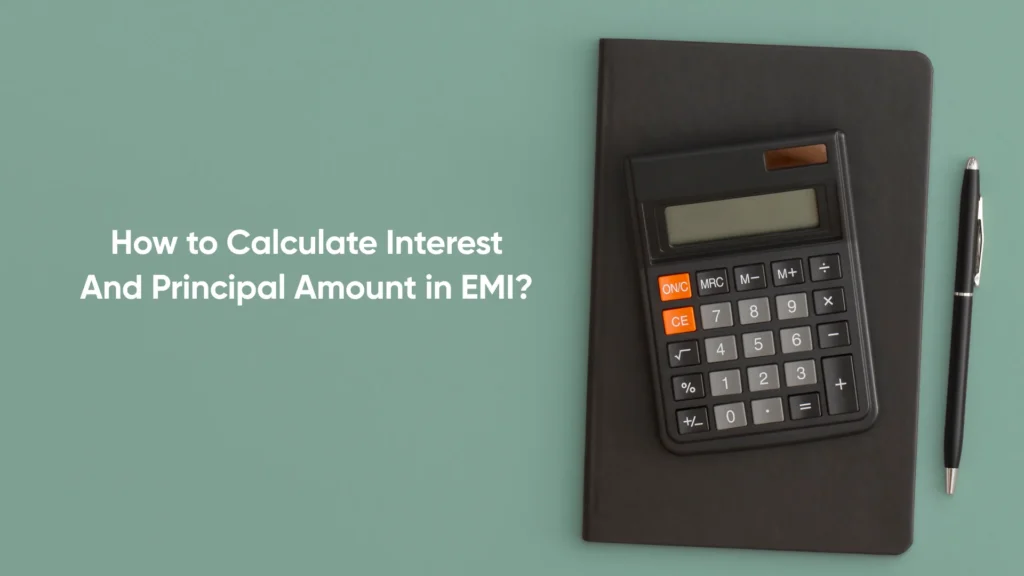How to Calculate Interest And Principal Amount in EMI?

For any type of loan that one takes from a bank or any NBFC, one needs to repay this amount in monthly instalments, typically EMI (Equated Monthly Instalments). This amount comprises the loan amount along with the interest charged on it. This total amount is divided equally by the total number of months over which one agrees to repay the personal loan.
This blog explains how one can calculate the interest and principal amount of EMI.
Table of Contents
ToggleWhat is an EMI?
The full form of EMI is Equated Monthly Instalments. It is called “equated” since this amount is equally distributed for the entire loan term. This is the fixed monthly amount that the borrower must repay towards their loan. The EMI amount consists of part of the principal amount and the interest amount. Typically, the EMI remains constant throughout the loan tenure. In some cases, it may change if there is a revised interest rate or repayment term.
Understanding Principal Amount and Interest Components
The EMI amount consists of the principal amount and interest amount:
- Principal Amount: It is the initial loan amount that is offered to the borrower. This amount forms the base on which interest is calculated
- Interest Components: It is the cost of borrowing that the borrower must pay each month. It is the percentage of the outstanding loan amount charged by the lender for the loan. For instance, the interest rate of 8% per annum means that for every ₹1,000 you borrow, you will need to pay an additional ₹80 as interest each year until the loan is repaid.
Also Read: What is Personal Loan Repayment and Types of Loan Repayment Methods?
Formula for Calculating EMI
The EMI formula can be calculated considering the principal amount, interest rate, and loan tenure
Formula: EMI = [P × R × (1+R)^N] / [(1+R)^N-1]
P: Principal loan amount
R: Monthly interest rate
N: Total number of months (loan tenure)
Understanding EMI calculation is important to manage loan repayments and manage your finances effectively.
Step-by-Step Guide to Calculate Principal and Interest
Here is our guide to calculate the principal and interest components for each EMI:
1. Gather the Loan Details
- Loan Amount (P): The total amount borrowed.
- Annual Interest Rate (R): The percentage charged as interest per year.
- Loan Tenure (N): Total repayment period in months.
- EMI: Pre-calculated monthly installment.
2. Calculate Monthly Interest Rate
Divide the annual interest rate by 12 and convert it to a decimal:
Monthly Interest Rate (r) = [Annual Interest Rate] / [12 *100]
3. Calculate Interest for the Month
Once the monthly interest is calculated, you need to subtract the monthly interest rate from the outstanding amount.
[Interest] = [Outstanding Principal] * [Monthly Interest Rate]
4. Calculate Principal Repayment for the Month
After you get the principal repayment for the month,
Principal = EMI – Interest
5. Update the Outstanding Principal
[New Outstanding Principal] = [Previous Principal] – [Principal Repaid]
EMI Calculation Example
EMI=P * R *(1+R)^(N)/[(1+R)^(N)-1])
Where,
P: is the principal amount
N: is the loan tenure in months
R: is the monthly interest rate
Let us consider,
- Principal (P): ₹5,00,000
- Loan Tenure (N): 2 years (24 months)
- Annual Interest Rate: 12%
- Monthly Interest Rate (R): (12%)/12=1%=0.011
EMI= [ 5,00,000 * 0.01 * (1+0.01)^24] / [(1+0.01)^24−1]
Calculating step-by-step:
- (1+R)^N= (1+0.01)^24 = (1+0.01)^(24) = 1.2682
- Numerator: 5,00,000 * 0.01 * 1.2682 = 6,341
- Denominator: 1.2682−1= 0.2682
- EMI: 6,341/0.2682= ₹23,652
Manual vs. Excel EMI Calculation
Here’s a comparison of Manual vs. Excel EMI Calculation:
| Factor | Manual Calculation | Excel Calculation |
| Formula | EMI=[P*R*(1+R)^N] / [(1+R)^N−1] | Excel Calculation = PMT (Rate, Nper, Pv) |
| Error Probability | High possibility of human errors due to complex calculations | Less errors. Excel automates the formula, reducing the chances of errors. |
| Convenience | Manual calculation is time-consuming. It requires multiple steps and careful calculations. | Quick and easy process. Excel offers automatic calculations with simple inputs. |
| Execution Time | Takes long time to calculate complex datasets | Gives quick output regardless of the dataset size |
Best For
| Small-scale calculations or for educational purposes.
| Best for large-scale, professional, or quick financial analyses |
Amortization Table: Month-by-Month Breakdown
The EMI that you pay has two components- principal and interest. At the beginning of the loan repayment schedule, a majority portion goes towards interest payment. It keeps reducing gradually, as the principal component goes up.
Here is an example amortization table for Mr. X’s loan of ₹15,00,000 at a 12% annual interest rate for 5 years. We have considered the first 10 months in the table
| Month | EMI | Principal Component | Interest Component | Outstanding Principal |
| 1 | 33,366.67 | 18,366.67 | 15,000.00 | 14,81,633.33 |
| 2 | 33,366.67 | 18,550.34 | 14,816.33 | 14,63,082.99 |
| 3 | 33,366.67 | 18,735.84 | 14,630.83 | 14,44,347.15 |
| 4 | 33,366.67 | 18,923.20 | 14,443.47 | 14,25,423.95 |
| 5 | 33,366.67 | 19,112.43 | 14,254.24 | 14,06,311.52 |
| 6 | 33,366.67 | 19,303.56 | 14,063.12 | 13,87,007.96 |
| 7 | 33,366.67 | 19,496.59 | 13,870.08 | 13,67,511.37 |
| 8 | 33,366.67 | 19,691.56 | 13,675.11 | 13,47,819.81 |
| 9 | 33,366.67 | 19,888.47 | 13,478.20 | 13,27,931.34 |
| 10 | 33,366.67 | 20,087.36 | 13,279.31 | 13,07,843.98 |
How Loan Tenure and Interest Rates Impact EMI
The loan tenure and interest rates impact the EMI that a borrower has to pay each month.
Impact of Loan Tenure on EMI
- Long Tenure: A longer loan tenure (5-10 years) reduces the monthly EMI because the loan amount is spread over more months. However, it results in higher total interest payments over the life of the loan.
- Shorter Tenure: A shorter tenure increases the EMI because the loan amount must be repaid in fewer months. But the total interest paid overtime will be lower, as the loan principal is cleared faster.
Example:
Loan Amount: ₹10,00,000
Interest Rate: 10% per annum
EMI for 5 years: ₹21,278
EMI for 10 years: ₹13,215
Although the EMI for the 10-year loan is lower, the total interest paid in the 10-year scenario will be higher.
Impact of Interest Rates on EMI
Changes in repo rate directly influence loan interest rates. If the RBI increases the repo rate, banks typically raise interest rates, leading to higher EMIs for floating-rate loans. Conversely, when the repo rate decreases, loan EMIs may reduce as banks pass on the benefit. Fixed-rate loans remain unaffected during their fixed term.
Higher interest rates can lessen the demand for loans, impacting the borrower’s spending and investment. On the other hand, lower interest rates encourage borrowing, boosting economic growth
For instance: You take a loan of ₹5 lakhs at an interest rate of 10% for a tenure of 3 years. The EMI for this loan would be approximately ₹16,134. If the interest rate increases by 2% to 12%, the EMI rises to ₹16,611. That’s an additional ₹477 every month. This shows how even a 2% rise in interest rates can significantly affect your monthly budget, especially for short-term loans.
To reduce the impact of changing interest rates, a borrower can opt for a longer loan tenure or make pre-payments to reduce the principal amount.
Also Read: Long Term Personal Loans
Conclusion
It is important to understand the components of a loan for effective EMI payments. While you can manually calculate interest rate and principal amount in EMI, you can use Zype’s EMI principal and interest calculator. Knowing how loan tenure and interest rate impact the EMI amount will help you select the right loan structure that best fits your financial needs.
Frequently Asked Questions
How To Calculate Monthly Principal And Interest In Emi?
To calculate the monthly principal and interest in an EMI (Equated Monthly Installment), use the formula:
EMI = [P x R x (1+R)^N] / [(1+R)^N – 1]
Where,
“P” is the principal amount borrowed,
“R” is the monthly interest rate,
“N” is the loan tenure in months
How Do You Calculate Principal And Interest?
The formula for calculating simple interest is: I=PRT, where:
I: The amount of interest
P: The principal amount
R: The rate of interest
T: The amount of time
How Do I Calculate 8% Interest On A Loan?
To calculate 8% interest on a loan, you can use the simple interest formula: S.I=P*R*T
Where,
SI: is the simple interest
P: is the principal amount
R: is the interest rate, expressed as a decimal
T: is the time period, in years
For example, if you invest ₹1,00,000 at an 8% annual interest rate for 2 years, the interest earned will be ₹16,000.
What Is The Formula For Emi In Simple Interest?
The formula to calculate EMI for simple interest
EMI = [P * R * (1+R)^N]/[(1+R)^N-1],
Where,
P: Represents the principal loan amount
R: Monthly interest rate
N: Number of monthly installments
How To Calculate Emi Manually With An Example?
To calculate an EMI manually, use the formula:
EMI = [P * R *(1+R)^N] / [(1+R)^N – 1]
Where,
P is the principal loan amount,
R is the monthly interest rate,
N is the loan tenure in months
Example:
Loan amount (P): ₹5,00,000
Annual Interest Rate: 10%
Loan Tenure (N): 3 years (36 months)
Calculation:
Monthly Interest Rate (R): 10% / 12 / 100 = 0.0083
EMI:[5,00,000 x 0.0083 x (1+0.0083)^36] / [(1+0.0083)^36 – 1]
EMI = ₹16,124.21 (approx.)
How To Calculate Interest For A Month?
To calculate interest for a month, you need to use the formula
Example:
Principal (P): ₹50,000
Annual Interest Rate (R): 8%
Period (T): 3 years
Simple Interest = (P * R * T)/100)
How Can I Calculate The Interest And Principal Separately In My Emi?
To calculate interest and principal separately in an EMI:
Interest for the 1st month = Principal × Monthly interest rate (R).
Principal for the first month = EMI – Interest for the first month.
What Is The Difference Between Reducing Balance And Flat Rate Emi?
Reducing Balance EMI: Interest is calculated on the remaining loan balance, so the interest amount decreases as the principal is repaid. EMI reduces overtime.
Flat Rate EMI: Interest is calculated on the entire principal loan amount, regardless of repayments. EMI remains fixed throughout the loan tenure.
YOU MAY ALSO LIKE

Search by posts
Recent post
-
 Instant ₹10,000 Loan Without Salary Slip – Quick Approval
Instant ₹10,000 Loan Without Salary Slip – Quick Approval
-
 समान मासिक किस्त: आपकी वित्तीय खर्चों को आसान बनाने वाला तरीका
समान मासिक किस्त: आपकी वित्तीय खर्चों को आसान बनाने वाला तरीका
-
 Apply for 50000 Rupees Loan Urgently: Get Disbursed in Few Minutes
Apply for 50000 Rupees Loan Urgently: Get Disbursed in Few Minutes
-
 How to get Instant Loan on Aadhaar Card without Salary Slip
How to get Instant Loan on Aadhaar Card without Salary Slip
-
 How to Apply for a Rs. 25,000 Loan on an Aadhaar Card?
How to Apply for a Rs. 25,000 Loan on an Aadhaar Card?
Categories
- Blog (6)
- Credit History (36)
- Credit Line (7)
- Festive (4)
- Finance (15)
- Mutual Fund (19)
- Personal Loan (276)
- Tax (8)
- Zype (4)













